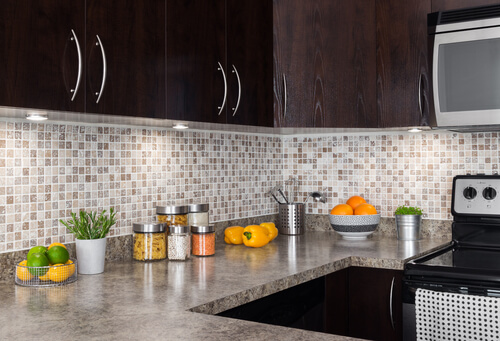Color | Usage | Material | Style | Shape | Conclusion
It’s a good idea to put kitchen design tiles in your kitchen because they don’t get dirty quickly and don’t need as much maintenance as other types of flooring, especially traditional flooring. Whether you are building a new kitchen or just updating the one you already have, choosing suitable tiles for the space is essential.
On the walls, they will protect the workplace, like behind the stove and along the backsplash. They are long-lasting, easy to clean, and pleasant to look at when used as kitchen floors. Your kitchen is the only room in your house where you can get away with using different tiles in different ways, and they will all make your kitchen look beautiful. When choosing tiles for your kitchen, you should consider where they will go first.

Best Tips for Suitable Kitchen Design Tiles
#1 Color of the tiles
If you choose the right color for the tiles, you can change the whole feel of the kitchen and boost its overall decorative value. Using specific colors can also give the impression that a room is more significant than it is.
One of the first and most important things you need to consider is the color scheme you want to end up with when the installation is done. Because cream and gray are often the most popular colors for kitchen cabinets and countertops, there are usually a lot of tile colors and designs to choose from, which can be pretty overwhelming.
Many different kinds of ceramic and porcelain tiles can be used in the kitchen. These tiles can look like stone or wood, come in different colors and patterns, and have different finishes. This gives you the freedom to make the finish you want.
Using black and white for the kitchen wall tiles gives the room a classic and elegant look. This color scheme works well for a modern kitchen because it can be used to make a monochromatic design.
#2 Usage of the tiles
Before picking a material, you’ll need to decide where the tile will go and what it will be. As a backsplash, you can put tiles on the wall behind the stove or tile the wall all the way up to the top cabinets. Tile is a common choice for kitchen countertops, and it can also be used to cover the kitchen floor.
Consider carefully where the tiles will be put while pausing for a while. However, remember that the tiles you choose should be quickly resistant to grease and easy to clean. Make sure the tiles you choose for your project are the right size for the design you have in mind, especially if you have a small kitchen.
#3 Material of the tiles
It would help if you thought about the material you want to use for the tiles you want to buy. If the tiles are next to the stove or on the floor, where they will get a lot of use, choose a shiny and easy-to-clean finish. This will help them keep their good looks for longer. Textured tiles look good everywhere, but they work best in areas that don’t get much foot traffic.
Even though kitchen tile is strong, it still needs to be cared for, and how long it lasts depends on the material. Ceramic tile is easy to clean and maintain and is also heat-resistant and long-lasting, making it an excellent material for countertops.
#4 Tiles should match your style
Think about the authentic style of the building your kitchen is in. After that, you’ll need to choose tiles that match the style of the room, so keep that in mind when you’re out shopping.
The design of the tiles in your kitchen can be set up and arranged in any way you like. There are many different colors, shapes, and designs on the market that you can use to give your kitchen a modern and elegant look.
People who want their homes to look neutral and modern often choose smooth tiles and the colors white, cream, or gray. On the other hand, many patterned tiles look more traditional or even farmhouse.
#5 Shape of the tiles
A large assortment of tiles is available nowadays in various sizes and shapes. Consider what would work well in your kitchen—in terms of size, style, and color—and make your selections based on that consideration.
The use of color, reflectivity, patterned tiles, or tiles laid in a pattern like a hexagon. Unique tile shapes like hexagons or fish-scale tiles, natural stone or an imitation of natural stone, or man-made material that resembles natural stone can all be used to make a tiled splashback a feature.
Conclusion
The modular kitchens of today provide a wide variety of design-focused components. These characteristics seamlessly integrate the modular kitchen’s ease of use, increased storage capacity, and durability.
Due to its ease of cleaning and maintenance and the extensive range of design options available, employing tiles in the kitchen area has become increasingly popular in recent years. It’s advisable to hire a specialist to assist you with the installation if you don’t have the right equipment to cut the tile material or invest in expensive tiles.
